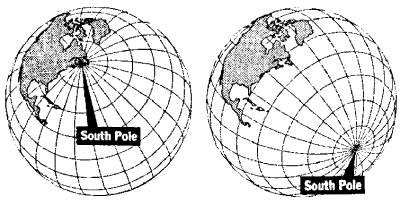 |
Science Frontiers ONLINE No. 113: Sep-Oct 1997 |
|
|
Earth's Shifting Crust
Our title is identical to that of a book published by C.P. Hapgood in 1958. He also wrote The Path of the Pole (1970). Several other authors have also proposed that sudden slippages of the earth's crust caused wild climate fluctuations in the past with devastating biological consequences -- in particular, all those quickfrozen mammoths in Siberia. These poleshift scenarios coming from thinkers swimming far out of the scientific mainstream have been studiously ignored in a "new" and well-publicized pole-shift theory recently appearing in Science. The "new" theory relates to an old (534-millionyears-ago) crustal slippage, whereas Hapgood was talking about a cataclysm within the last 10,000 years or so. Nevertheless, it would have been nice to see Hapgood's earlier work acknowledged.
Four features of this "new" proposal make it more palatable than Hapgood's to today's geologists and geophysicists:
- Two of the "new" authors, J. Kirschvink and D.A. Evans, are at the prestigious California Institute of Technology, while Hapgood was a PhD-less history professor at Keene State College. Status is important when theorizing.
- Kirschvink et al propose a scientifically acceptable mechanism for the onset of rapid crustal slippage. They visualize a huge chunk of the seafloor suddenly foundering and thereby changing the planet's mass distribution. This imbalance caused the continents to shift rapidly in order to restore the smooth rotation of the earth around its spin axis. Within a period of 15 million years, they envisage, the continents had slipped about 90�. Part of what is now North America moved from the South Pole to near the Equator. Evidence for this huge shift is seen in measurements of the earth's magnetic field frozen in the rocks. In other words, Kirschvink et al used the methods of paleomagnetism.
- The "new" crustal slippage is really only accelerated continental drift (a dominant and well-established paradigm) and not the more radical notion of the entire outer layer of crust slipping over the earth's mantle like a greased onion skin. Nor is the proposed process anything like poleflipping, where the entire planet flips 180� like a Tippy-Top -- a dynamically impossible event. (SF#6/224)
- The proposed foundering of that chunk of seafloor occurred 534 million years ago, roughly coincident with the Cambrian Explosion of new life forms (new phyla). The resulting gross climate changes and environmental havoc could have been conducive to the rapid evolution of life. Although today's scientists favor this linkage of catastrophism to rapid speciation, Berkeley paleontologist J. Valentine admitted that, "...it doesn't provide a specific mechanism by which animals suddenly evolved new "body plans." Even so, scientists have long searched for an event -- any -- that might explain the puzzling Cambrian Explosion.
(Kirschvink, Joseph L., et al; "Evidence for a Large-Scale Reorganization of Early Cambrian Continental Masses by Inertial Interchange True Polar Wander," Science, 277:541, 1997. Also: Sawyer, Kathy; "Global Shift May Have Sped Evolution," Washington Post, July 25, 1997.)
Comment. O.K., but those much more recent frozen mammoths are still hard to explain. If a chunk of seafloor can founder once, the same thing might have happened twice -- say, just a few thousand years ago. But why should large chunks of seafloor sink so suddenly? Neither reference touches on this!
K. Wise has pointed out that actually the Cambrian Explosion did not see the greatest increase in biological innovation. The earlier Archaean Explosion produced 17 new phyla of bacteria employing an extraordinary range of different metabolisms. Although some 38 new phyla did emerge from the Cambrian Explosion, they utilized only one type of metabolism.
(Wise, Kurt P., "The Archaean Explosion," CEN Technical Journal, 10:315, 1996.)
Comment. What triggered the more innovative Archaean Explosion?
Reference. Our Catalog Inner Earth contains a long section entitled "Problems in Measuring and Interpreting Paleomagnetism." This book is described here.
 | This 90� pole shift was synchronous with the Cambrian Explosion of new life forms. Of course, North America really looked quite different then. See Astonomy for a Martian pole shift. |